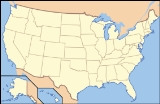
Petroglyph National Monument
Encyclopedia

Albuquerque, New Mexico
Albuquerque is the largest city in the state of New Mexico, United States. It is the county seat of Bernalillo County and is situated in the central part of the state, straddling the Rio Grande. The city population was 545,852 as of the 2010 Census and ranks as the 32nd-largest city in the U.S. As...
's West Mesa
West Mesa
right|300px|thumb|View of downtown Albuquerque and the Manzano Mountains from the West MesaThe West Mesa is an elevated landmass lying west of the Rio Grande River stretching from south of Albuquerque northward to Bernalillo in the U.S. state of New Mexico. The eastern edge of the West Mesa is...
, a volcanic basalt
Basalt
Basalt is a common extrusive volcanic rock. It is usually grey to black and fine-grained due to rapid cooling of lava at the surface of a planet. It may be porphyritic containing larger crystals in a fine matrix, or vesicular, or frothy scoria. Unweathered basalt is black or grey...
escarpment
Escarpment
An escarpment is a steep slope or long cliff that occurs from erosion or faulting and separates two relatively level areas of differing elevations.-Description and variants:...
that dominates the city’s western horizon. Authorized June 27, 1990, the 7,236 acre
Acre
The acre is a unit of area in a number of different systems, including the imperial and U.S. customary systems. The most commonly used acres today are the international acre and, in the United States, the survey acre. The most common use of the acre is to measure tracts of land.The acre is related...
(29.28 km2) monument is cooperatively managed by the National Park Service
National Park Service
The National Park Service is the U.S. federal agency that manages all national parks, many national monuments, and other conservation and historical properties with various title designations...
and the City of Albuquerque. The western boundary of the monument features a chain of dormant fissure volcano
Volcano
2. Bedrock3. Conduit 4. Base5. Sill6. Dike7. Layers of ash emitted by the volcano8. Flank| 9. Layers of lava emitted by the volcano10. Throat11. Parasitic cone12. Lava flow13. Vent14. Crater15...
es. Beginning in the northwest corner, Butte volcano is followed to its south by Bond, Vulcan, Black
Black Volcano
Black Volcano is a inactive volcano located near Albuquerque, New Mexico, and is part of the Albuquerque volcanic field. Black Volcano is located directly north of JA volcano. Black Volcano is the second of five volcanoes within the western boundary of Petroglyph National Monument. North of Black...
and JA volcano
JA volcano
JA Volcano is an inactive volcano located near Albuquerque, New Mexico. JA Volcano is the southern most of 5 volcanoes in a 5-mile chain within the western boundary of Petroglyph National Monument. Directly north of JA is Black, followed by Vulcan, Bond and Butte volcanoes.The date of its last...
es.
Petroglyph National Monument protects a variety of cultural and natural resources including five volcanic cones, hundreds of archeological sites and an estimated 24,000 images carved by Ancestral Pueblo
Pueblo
Pueblo is a term used to describe modern communities of Native Americans in the Southwestern United States of America. The first Spanish explorers of the Southwest used this term to describe the communities housed in apartment-like structures built of stone, adobe mud, and other local material...
peoples and early Spanish settlers. Many of the images are recognizable as animals, people, brands
Livestock branding
Livestock branding is a technique for marking livestock so as to identify the owner. Originally, livestock branding only referred to a hot brand for large stock, though the term is now also used to refer to other alternative techniques such as freeze branding...
and crosses; others are more complex. Their meaning was, possibly, understood only by the carver. These images are the cultural heritage
Cultural heritage
Cultural heritage is the legacy of physical artifacts and intangible attributes of a group or society that are inherited from past generations, maintained in the present and bestowed for the benefit of future generations...
of a people who have long since moved into other areas and moved on through history for many reasons. The monument is intended as a protection for these lands and sites from and for visitors to see and appreciate for generations to come. The National Monument is managed in a manner that allows recreational use.
Stupa controversy
In 1989, at least a year prior to the National Monument's establishment, a Tibetan Buddhist stupaStupa
A stupa is a mound-like structure containing Buddhist relics, typically the remains of Buddha, used by Buddhists as a place of worship....
was built and consecrated on what was then private land owned by Harold Cohen and Ariane Emery. The National Park Service subsequently used eminent domain
Eminent domain
Eminent domain , compulsory purchase , resumption/compulsory acquisition , or expropriation is an action of the state to seize a citizen's private property, expropriate property, or seize a citizen's rights in property with due monetary compensation, but without the owner's consent...
to seize this land and make it part of the Monument, over the owners' objections. The stupa was not removed, but all buildings on the land were razed.
On June 10, 2010, the Superintendent of Petroglyph National Monument sent an email stating that "[w]hile soils are being stockpiled nearby for the future construction of an amphitheater, the National Park Service has no plans for the Stupa." This contradicts verbal information given by at least one park ranger at the Monument. The Monument website was also updated to describe the construction projects and clarify that the Stupa was not to be demolished.

